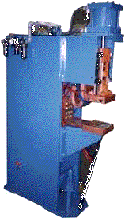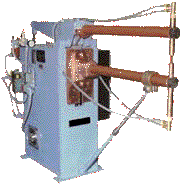Resources
Weld Data Guide
|
Weld Data Guide |
Weld Settings |
|
| Weld Guide 2020.pdf | ||
|
About Ohio Weld Fasteners
|
Janda Co. Inc.
1275 Railroad Street
Corona, CA 92882 USA
Phone: (951) 734-1935
Fax: (951) 734- 0649
Web Site: jandawelders.com
Standard Resistance Welder Co.
7833 Conners Road
Winston, GA 30187 USA
Phone: (770) 949-2479
Fax: (770) 489-1826
Web Site: srwelder.com
Email: Sales@srwelder.com
Automation International Inc.
1020 Bahls St.
Danville, IL 61832 USA
Phone: (217) 446-9500
Fax: (217) 446-6855
Web Site: automation-intl.com
Email: Sales@automation-intl.com
Sclaky Brothers Inc.
4915 West 67th Street (Department TR-85
Chicago, IL 60638 USA
Phone: (708) 594-3800
Fax: (708) 594-9213
Web Site: sciaky.com
GWI Engineering Inc.
1411 Michigan Street NE
Grand Rapids, MI 49503 USA
Phone: (616) 459-8274
Fax: (616) 459-3390
Web Site: gwiengineering.com
RWC Inc.
2105 South Euclid Avenue
Bay City, MI 48706-3409 USA
Phone: (515) 684-4030
Web Site: rwcinc.com
Matuschek Resistance Welding
42378 Yearego
Sterling Heights, MI 48314 USA
Phone: (586) 991-2434
Fax: (586) 991-2438
Web Site: matuschek.de
Spotco
125 8th Avenue S.W.
New Brighton, MN 55112 USA
Phone: (651) 638-9711
Fax: (651) 638-0713
Web Site: Spotco.com
Email: Sales@Spotco.com
Spot Weld Inc.
2290 Wycliff Street
ST. Paul, MN 55114 USA
Phone: (651) 646-1393
Fax: (651) 646-3616
Web Site: spotweldinc.com
Email: Sales@SpotWeldInc.com
Lors Machinery
1090 Lousons Road
Union, NJ 7083 USA
Phone: (800) 223-0909
Fax: (908) 964-4492
Web Site: lors.com
Email: Sales@Lors.com
WeldComputer Corporation
Rensselaer Technology Park
105 Jordan Road
Troy, NY 12180
G. E. Schimdt
11236 Willams Road
Cincinnati, OH 45241 USA
Phone: (513) 489-5130
Fax: (513) 489-5132
Web Site: geschmidt.com
Email: Sales@geschmidt.com
Retek Inc.
34550 Chester Road
Avon, OH 44011 USA
Phone: (440) 937-6282
Fax: (440) 937-6320
Web Site: retekinc.com
Email: Sales@RetekInc.com
Taylor Winfield Technologies
3200 Innovation Place
Youngstown, OH 44509 USA
Phone: (330) 259-8500
Fax: (330) 259-8538
Toll Free Phone: (800) 523-4899
Web Site: taylor-winfield.com
Email: Sales@taylor-windfield.com
W.S.I. Weld Systems Integrators
4943 Driscoll Road
Warrensville, OH 44146 USA
Phone: (216) 475-5629
Fax: (216) 475-5679
Web Site: srwelder.com
Email: Sales@srwelder.com
TFP Corp.
T.J. Snow Company
120 Nowlin Lane
P.O. Box 22847
Chattanooga, TN 37421 USA
Fax: (423) 892-3889
Toll Free Phone: (800) 669-7669
Web Site: tjsnow.com
Email: Welders@tjsnow.com
Banner Welder Inc.
N 117 W 18200 Fulton Drive
P.O. Box 1008
Germantown, WI 53022 USA
Phone: (262) 253-2900
Fax: (262) 253-2919
Web Site: bannerweld.com
CenterLine Limited
P.O. Box 7068
Windsor, ON N9C 3Y6 Canada
Phone: (519) 734-0034
Fax: (519) 734-1838
Web Site: cntrline.com
Email: Sales@Centerline.com
Resistance Welding Products LTD
9270 MiddleLine ( Marlborough Street )
P.O. Box 670
Bienhelm, ON N0P 1 A0 Canada
Phone: (519) 676-8173
Fax: (519) 676-3329
Toll Free Phone: (800) 265-5262
New Southern Resistance Weld
701 Thames Court
Pelham, AL 35124 USA
Fax: (205) 663-3221
Toll Free Phone: 800-933-6779
Web Site: nsrw.com
Myachi
245 East 8 Norte Street
P.O. Box 5039
Monrovia, CA 91017-7133 USA
Phone: (626) 256-4128
Fax: (626) 303-5396
Web Site: Miyachi.com
Email: Sales@Miyachi.com
B. L. Downey Company Inc.
2125 Gardner Road
Broadview, IL 60155 USA
Fax: 708-345-8017
Toll Free Phone: 800-323-1206
Web Site: bldowney.com
Email: info@bldowney.com
Weltronic / Technitron Corp
150 East St. Charles Road
Carol Stream, IL 60188-2083 USA
Phone: (630) 462-8250
Fax: (630) 462-8259
Toll Free Phone: 800-323-2903
Web Site: Weltronic.com
Quality Feeders Inc.
9960 North 600 East
Wilkinson, IN 46186 USA
Phone: (317) 326-4660
Phone: (317) 326-4609
Fax: (317) 326-4661
Clyde Corp. Clydematic Products
11905 Mayfield
Livernois, MI 48150-1710 USA
Phone: (734) 261-6480
Fax: (734) 266-0919
Web Site: clyde-online.com
Email: info@Clyde Corp.com
Feedmatic
5251 M33 Highway
Cheboygan, MI 49721 USA
Phone: (618) 627-7171
Fax: (616) 627-9929
Owosso Automation Inc.
1507A West Oliver Street
Owossa, MI 48867 USA
Phone: (989) 725-8804
Fax: (989) 725-8804
Web Site: Owosso Automation
Email: info@Owosso.com
Tipaloy Inc.
1435 E. Milwaukee Ave.
Detroit, MI 48211-2009 USA
Phone: (313) 875-5145
Fax: (313) 875-6027
Web Site: Tipaloy.com
Email: info@Tipaloy.com
Dengensha America Corp.
7603 First Place Drive B-4
Oakwood, OH 44146 USA
Phone: (440) 439-8081
Fax: (440) 439-8217
Web Site: dengensha.com
Fastfeed
124 South Academy
Lodi, OH 44256 USA
Phone: (330) 948-7333
Fax: (330) 948-8603
Web Site: fastfeed.com
Email: info@fastfeed.com
RobotWorx
370 W. Fairground St.
Marion, OH 43302 USA
Phone: (740) 383-8383
Fax: (740) 383-3939
Web Site: robots.com
Serntorq Inc.
395 Gentry Road
Aurora, OH 44202 USA
Phone: (330) 995-7676
Fax: (330) 995-7670
Web Site: semtorq.com
Advance Portable Welding Fab
648 Moore Road
Avon Lake, OH 44012 USA
Fax: (440) 949-5608
Toll Free Phone: 800-890-1009
Web Site:advancedportablewelding.com
Yoder Machinery
Web Site: Yoder Machinery
Tuffaloy Products
1400 Batesville Road
Greer, SC 29650 USA
Toll Free Phone: 800-521-3722
Web Site: tuffaloy.com
Email: Sales@Tuffaloy.com
Entron Controls
1402 S Batesville Road
Greer, SC 29650 USA
Phone: (864) 416-0190
Fax: (864) 416-0195
Web Site: entroncontrols.com
Email: info@entroncontrols.com
Eurobots Industrial Machinery Export
Bilbao S.L. Pollgono Industrial Pinoa
Parcela 1 C 48170 Zamudlo
Bilbao, Spain
Phone: 34-946-744-397
Fax: 34-946-741-786
Web Site: Eurobots.net
Email: info@eurobots.net
Techno Aoyama Inc.
1-1 Fukasaka
Sakai City, Osaka 599-8253 Japan
Phone: 011-81-72-234-3320
Fax: 011-81-72-236-5918
Web Site: t-aoyama.co.jp
Email: Sales@Techno Aoyama Inc.com



